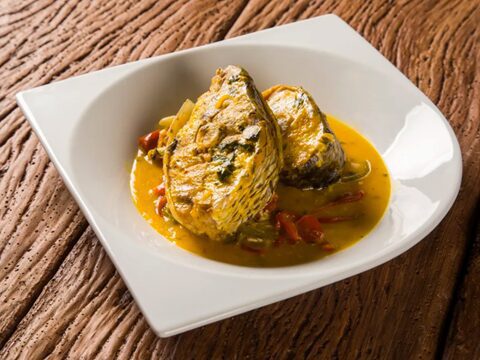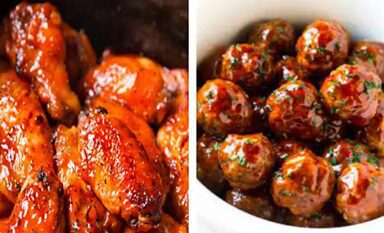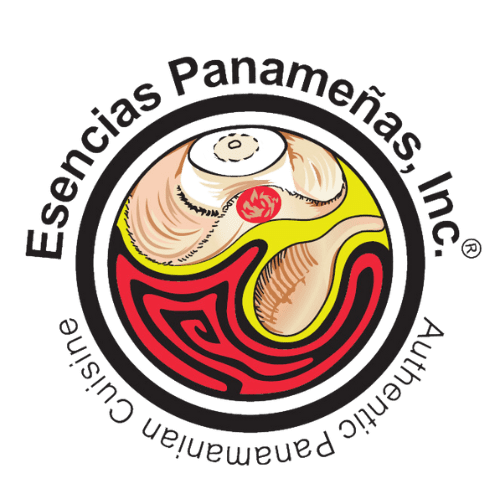FEBRUARY 2023
FEBRUARY 2023 ISSUE 14

Chef’s Monthly Insight . . . .
BLACK HISTORY MONTH
BLACKS IN PANAMA
February 1st marks the beginning of Black History Month in the U.S. when we recognize and honor African Americans' momentous achievements and contributions, past and present. It is a time to learn and celebrate similar heritage events throughout the world. Although in Panama Black History is celebrated on May 31st (Etnia Negra Nacional), I think it is most appropriate to also celebrate the heritage events of Blacks (Afro Latinos) in Panama, this month.
In 2022, Panama’s population was 4,431,583, and black Panamanians represented about 20% of the total population. The vast majority (64%) are known as mestizos (a person of mixed European and Indigenous ancestry); 24% are mulattos (a person of mixed African and European ancestry); and 12% are zambos (a person of mixed African and Indigenous ancestry). Therefore, it could be said that 56% of the Panamanian population is Afro-descendant or has some African ancestry.
Black Panamanians on the Isthmus are mainly broken into two categories:
Afro-Colonials – which are Afro-Panamanians descended from slaves brought by the Spaniards in the 1500s, from Guinea, Senegal, and Angola. Spain used Panama as the major commercial center for its American colonies for two centuries. The slaves transported goods back and forth from the Atlantic to the Pacific side along the “Camino Real” which was built between Panama City and the Caribbean port of Nombre de Dios. The slaves were also sent to work in the nearby gold mines of Veraguas and Darien.
Panama was also important as a slave-trading center. Regional slave markets were established in Portobelo and Panama City (Panama Viejo), where thousands of enslaved Africans were sold to Spanish planters and miners from Colombia, Ecuador, Peru, and Bolivia, as well as from Panama itself. Many Africans also escaped from forced labor conditions during the colonial era fleeing into the remote jungles in Darien and forming free communities. Some intermarriage occurred between Africans and indigenous communities and today those Afro-Indians (a.k.a. Maroons) descendants known as Costeños still live along the rivers and coastal areas of Darien.
Afro-Antilleans – which are West Indian immigrant descendants from the Caribbean brought by the French, beginning in the 1830s, from Jamaica, Barbados, Martinique, and Trinidad, initially to work in commercial agricultural enterprises and on construction projects, including the construction of the trans-Isthmus Panama railroad in 1846.
At the end of the railroad construction in 1855, some Afro-descendant workers remained and settled in the province of Bocas del Toro where they began farming smallholdings. This included pioneering the cultivation of bananas in Central America, and The United Fruit Company and the Chiriqui Land Company were established in Panama (Bocas del Toro) and Costa Rica (Puerto Limon), which they sold to US exporters. These events raised the need for more Caribbean laborers.
The next major wave of West Indians (about 38,000) came between 1907 and 1914 for the construction of the Panama Canal. After the construction of the Canal was completed, some 20,000 laborers chose to stay in Panama and they got jobs in the Canal Zone, becoming the largest immigrant group in Panama. By the 1930s, this migration changed the demographics of Panama City and Colon, around the Panama Canal.

Food played a significant role in enriching our multicultural identity. From the miners to the railroad builders, to the Canal builders, food was the way that they connected and fellowshipped. Because they worked long hours, their lunch boxes would always include hearty meals. Black Panamanian gastronomy is characterized by the high consumption of rice, tubular root vegetables (aka “ground food”), and seafood. Major agricultural products include rice, sugar cane, coconut, bananas, cocoa beans, coffee, and shrimp. Traditional dishes include fried bakes, journey cakes (a.k.a. johnnycakes, yaniqueque), run down (fish and ground food soup), fry fish, coconut rice, cow foot soup, saus (pickle pig feet), and salted codfish cakes. And don’t forget the black-eyed peas and rice that is a must on New Year’s Day.
The three basic meals consisted of Breakfast, Lunch, and Supper. Breakfast was a must, and it had to include a hot beverage (tea/coffee) to prevent “gas” build-up 😊. We ate our lightest meal at Supper and our heaviest meal at Lunch. Lunch included a “siesta”, which was a 2-hour break when Panama would shut down to let everyone go home, where possible, and take a nap in the middle of the day, to refresh. Sunday was the day that families looked forward to, so as to enjoy “Sunday dinner”. Even those that emigrated to Panama by themselves always found a home to go to on Sundays. Black Panamanians Sunday dinner was served early afternoon, after church service, and usually consisted of coconut rice and peas (e.g., red beans, pinto beans, pigeon (gungu) peas), stewed chicken, fried sweet plantain, lettuce & tomato, or cucumber salad, and a slice of pear (avocado). Workers looked forward to Sunday dinner since it was the only day that the slaves and mine, railroad, and canal workers were able to rest from working long hours during the week. The women would prepare these scrumptious and rich foods made from premium ingredients and lots of spices.
There are many Black Panamanians that continue the “Sunday dinner” tradition to this day, no matter what part of the world they reside in. However, these “rich” foods do not always align with a healthy diet, and with diseases such as high blood pressure and diabetes, folks are forced to find ways to tweak recipes and make compromises, to ensure a more balanced meal.
I do not believe that one should completely sever ties with their cultural tradition because of health. I think that as long as you indulge in moderation, it is totally fine.
Chef’s Monthly Insight . . . .
CARNAVAL IN PANAMA




The etymology of the word Carnaval comes from the Genoese carnem levare, which means eliminate meat: the expression that indicates the banquet held on the last day before the period of fasting and abstinence from meat of the Christian Lent. Lent, by religious tradition, meant deprivation and Carnaval appears as the way to enjoy, without limits, everything that believers had to give up: food, drink, dance, and lust. This tradition emerged around the 1300s in Europe and was brought to America during the conquest, with the Afro-descendant population giving it the distinctive touch with dances and masks. In the Catholic liturgical calendar, Carnaval is placed between the Epiphany and Lent. Martedì Grasso (Fat Tuesday) marks the end of Carnaval, as Lent begins with Ash Wednesday.
Carnaval in Panama was made official in 1910, through a mayoral decree by the Mayor of Panama at the time, Jose Agustin Arango, who declared Carnaval a holiday. At that time, it was customary to dress up in costumes that were of characters from the colony, the king and queen of Spain, slaves, and soldiers. By 1935, we began to elect Carnaval queens to lead the parades with groups that represent different neighborhoods of the city. To be chosen as queen, the family must have a history in the town and must also be financially prepared to meet all the expenses that being queen entails. The first Carnaval queen was Manuelita Vallarino (1910).
The celebration begins on Friday night, with the coronation of the queen. On Saturday, the “culecos” is celebrated during the daytime, when dancing crowds are sprayed with water hoses from tanks on trucks. The queens also go out on their decorated floats accompanied by a multitude of people that play music and sing, known as “tunas”. Sunday is the day of the “pollera montuno” along with a theme consisting of either the history or the mythology of Panama. Monday is the most luxurious day. The queens come out with giant costumes, making it the most gala day. The last day is Tuesday when they wear their formal “pollera de gala” – Panama’s national costume.
Carnaval is celebrated in all provinces of Panama. However, the biggest and wildest Carnaval celebration is in Las Tablas, in the province of Los Santos. Carnaval in Penonomé, in the province of Cocle, is on the water. The aquatic Carnaval and its traditional parade of rafts constitute their biggest tourist attraction. The origin of the aquatic Carnaval in Penonomé is rooted in the customs of the indigenous people who used canoes to navigate the Zarati River, one of the main tributaries of this province.
Carnaval in the province of Bocas del Toro is different and unique from those in the other provinces since it depicts the celebration of the freedom of the slaves. The legend begins with a group of indigenous people called ‘Congos’ who were freed from the slavery they endured by the Spanish colonists. Their attire consists of clothing donated by the master that they tore in strips and wore inside out. The men painted their faces with charcoal; all this to mock the slave master. The Congos take to the streets to fight the ‘devils’, who represent the slave owners with their whips. The devils wear red and black costumes with scary-looking masks, and they run up and down the streets challenging anyone. Occasionally, the Congos challenge the devils with a stick and quick foot movements. On Ash Wednesday, the devils will come to the center of the Square with their masks off and in hand. They would then enter the church, where they would repent.
I am only familiar with Carnaval in Panama City, where it all started. While my friends and their families would travel to the interior of the country to enjoy Carnaval, we would stay in the city. Every year, I looked forward to traveling downtown to attend the parade. The floats were enormous, and the queens were beautifully dressed in colorful costumes. The parade was kicked off with 2 huge dolls-like named “Domitila” and “Tiburcio”, who represented the peasants that traveled from the interior of the country to Panama City to get away from their sorrows and enjoy the festivities for 4 days, and then return to their harsh reality on Ash Wednesday. Despite having a good time, I was always looking around my surroundings for the ‘resbalosos’, which were guys that would paint their whole body with oil paint and would chase after kids and women because they knew we were afraid of them 😊. Sadly, as time went on, Carnaval in Panama City began to get smaller and smaller because the people preferred to travel to the interior of the country to enjoy the festivities. Today, Las Tablas continue to be the main hub for Carnaval in Panama.
This year, Carnaval in Panama will be held from February 18th thru February 21st. The closing of the Carnaval will be celebrated at dawn on Wednesday, February 22nd, with a ceremony called “the burial of the sardine”, which consists of a parade that parodies a funeral procession and ends with the burning of a symbolic figure that represents a sardine. The burial of the fish is to redeem society from sin.
During Carnaval people are on the streets all day, so fried foods and finger foods are predominant since they do not require a large kitchen for their preparation. However, the foods available will depend on the province or city where you are, but some classic foods are common to all, such as carne en palito (beef kabob), hojaldas (fried flat bread), torrejitas de maiz (corn fritters), and torrejas de bacalao (codfish cakes). These are fast foods that you eat with your hands.
The weekend following Ash Wednesday is known as “Carnavalito” (or little Carnaval) or festivities for the locals. On Friday, the queen wears an evening gown and a crown. On Saturday, there is a culeco during the day, and at night, there is a small parade with one float. Carnavalito ends on Sunday in the province of Colon (or Domingo de Carnavalito).
What’s New This Month . . .
Super Bowl LVII will be played on Sunday, February 12, 2023, and Esencias Panameñas is ready for the big game with a special Super Bowl menu that includes three (3) Combos of game day eats:
LAST DAY TO ORDER IS FEBRUARY 6, 2023!!!

- COMBO1: MEATBOWL –
- Half tray: 25 mango BBQ wings / 25 sweet & sour meatballs / medium side yuca frita w/tamarind sauce. Serve 10 – 12 people – $85
- Full tray: 50 mango BBQ wings / 50 sweet & sour meatballs / large side yuca frita w/tamarind sauce. Serve 20 – 25 people – $160
- COMBO2: PANABOWL –
- Half tray: 25 mango BBQ wings / 25 carimañolas (yuca balls stuffed with ground beef OR ground chicken) w/tamarind sauce / 25 empanadas (ground beef or ground chicken filling). Serve 10 – 12 people – $85
- Full tray: 50 mango BBQ wings / 50 carimañolas (yuca balls stuffed with ground beef OR ground chicken) w/tamarind sauce / 50 empanadas (ground beef or ground chicken filling). Serve 20 – 25 people – $160
- COMBO3: VEGGIEBOWL –
- Half tray: 25 sweet & sour veggie balls / 25 veggie carimañolas (veggie yuca balls) w/tamarind sauce / 25 veggie empanadas. Serve 10 – 12 people – $85
- Full tray: 50 sweet & sour veggie balls / 50 veggie carimañolas (veggie yuca balls) w/tamarind sauce / 50 veggie empanadas. Serve 20 – 25 people – $160
LOCAL PICK-UP LOCATION:
TASTEMAKERS DC
2800 10th Street, NE
Washington, DC 20017
To Place Your Order

PANAMA ON A PLATE COOKBOOK!!!
My cookbook Panama on a Plate – Favorite Foods from my Birthplace is now available on EsenciasPanamenas.com (Paperback only): Panama on a Plate, Favorite Foods from my Birthplace - Cookbook (esenciaspanamenas.com)
My cookbook is also available online in bookstores, such as Barnes & Nobles, as well as on Amazon, in Paperback, Hardcover, and eBook versions.
NOTE: If you would like the book signed by me, you must purchase through my website.
Esencias Panameñas Trivia is Back! . . . . .

Esencias Panameñas will continue with the Food Trivia in our monthly newsletters. From now through December, we will provide you with five (5) questions each month, and each correct answer is worth 1 point. If you were to play all 12 months, you could earn up to 60 points. The player with the highest number of points will win the grand prize – Panama on a Plate (volumes 1 & 2). The winner will be announced on December 17, 2023.
We will share the correct answers to the questions the following month, so you can keep track of your winnings.
January Answers:
- Which of these is another name for a shiitake mushroom: Chinese black mushroom
- Which of these cooking vessels share a name with the dish that’s cooked in it: Tagine
- It is technically a fruit juice, but people don’t usually drink it straight: Olive Oil
- What spice harvested from the crocus flower is considered the world’s most expensive by weight: Saffron
- Which of these flavors was not one of the original JELL-O flavors released in 1897: Cherry
The participant with the highest score is:
Miriam O’Brien (5)
National Food Days in February . . .
February 3: National Carrot Cake Day
February 4: National Homemade Soup Day
February 9: National Bagels & Lox Day and Pizza Day
February 13: National Tortellini Day
February 18: National Drink Wine Day
February 20: National Cherry Pie Day and Muffin Day
February 21: National Rice & Peas Day – recipe to follow
February 22: National Margarita Day
February 24: National Tortilla Chip Day
February 27: National Strawberry Day
February 28: National Chili Day
Sharing One Of My Recipes With You . . .
From Sweet To Savory And Everything In Between
February 21st is National Rice & Peas Day, so below is my recipe for “Red beans and rice cooked in coconut milk”

INGREDIENTS
- 1 pound red kidney beans, dried (not canned)
- 3 teaspoons salt
- 2 bay leaves
- 4 tablespoons canola oil
- 2 pounds parboiled or long-grain rice
- 1 small onion, finely chopped
- 2 fresh thyme sprigs
- 2 cans pure coconut milk, plus 2 cans water
INSTRUCTIONS
- Dried pigeon peas: Remove from package, rinse thoroughly in cold water, and soak overnight or for at least 8 hours in enough water to cover peas by 4 to 6 inches.
- Discard soaking water and rinse peas in fresh cold water. Place peas in a large stockpot with a gallon of water, 1 teaspoon salt, and 2 bay leaves over medium-high heat and cook for 2 hours.
- Use a serving spoon to take out a few peas and stick with a fork to check for doneness. If still hard, cook for 30 more minutes and check again. Once soft, turn off heat, strain, discard liquid and bay leaves, and set aside.
- Rinse rice in cold water twice and pour through fine mesh strainer, discarding as much water as possible. Heat oil in Dutch oven over medium-high heat until shimmering. Stir in rice and cook until edges of rice begin to turn translucent, stirring constantly, 3 minutes. Add onions and thyme sprigs and continue to cook until softened, 3 more minutes.
- Stir in coconut milk, water, peas, and 2 teaspoons salt. Scraping up any brown bits at the bottom, stir until well combined. Add more water if needed so that total liquid covers rice by 1 inch. Simmer vigorously, uncovered, until all liquid evaporates.
- Reduce heat to low and cover lid tightly and continue to steam untouched for about 15 to 20 minutes.
- Remove pot from heat, uncover, and fluff rice using a serving spoon, adjust seasoning if needed, and serve with a protein of choice (e.g. stewed chicken), sweet plantains, and a side salad.
To View More Recipes
Culinary Humor . . .

Tricos y Trucos . . .
This month’s Tip: How do you know if your eggs are fresh or rotten

Eggs are one of the most consumed foods on the planet. They can be eaten on their own but are also used as an important ingredient in many recipes. Most eggs are sold with a “best before date” on them, but not all are. Many people will also risk eating an egg after this date has elapsed and find they are still perfectly edible. However, this is a big risk. If an egg is rotten and we eat it, it can contain dangerous bacteria which can lead to diseases such as salmonella.
Every egg in the supermarket is a Grade A egg, all farmed fresh and all hormone free. Although they may come in different colors, contrary to popular belief, nutrition, and flavor-wise, they are all the same. Therefore, color has no impact.
Pasteurized eggs are great if you want to use them in a raw application, such as a Caesar salad dressing. However, you would not want to use pasteurized eggs for a souffle, since the egg white will not whip as well. Organic eggs are regulated by the USDA, which means that the chickens are eating an organic diet and have access to the outdoors. Free-range eggs mean that the birds have access to the outdoors.
In the US, eggs must be kept in the refrigerator. That’s because supermarket eggs in the US are washed and that removes the protective cuticle on the shell, which can cause bacteria to get inside the egg. In addition, where you store the egg in the refrigerator matters. Although some refrigerators come with egg storage on the door, I would not recommend that you take them out of the carton and store them in the storage on the door, because it is too warm. The carton protects the eggs from odors, such as cheese, onions, etc., that are in the refrigerator, which can penetrate the eggshell. Therefore, it is best that you keep it in the carton or a closed plastic container inside the fridge, preferably in the back. Usually, eggs have an expiration date of 3-5 weeks; however, you can keep your eggs safely for up to 3 months. Remember, since you kept them in the refrigerator, they will remain fresh for months beyond that date.
Eating a bad egg can cause food poisoning, but before tossing in the garbage, here is an easy way to tell if it is still good: check the state of the egg without having to crack it open by using a glass of water. The test is more reliable using cold water instead of room temperature or hot water because temperature slightly affects water density. Place the egg in a glass full of water and see what happens:
- If the egg sinks quickly: it will mean that it is fresh because its shell is intact.
- If the egg sinks slowly: it means that it is still good, but you should consume it soon, as it will expire in the next few days.
- If the egg floats on the surface: it means that it is in bad condition and is not safe to consume. The egg floats when it is rotten because its shell becomes very porous.
If you don’t check the egg before you crack it open, then please be sure to check after you have cracked it open. My personal preference is to crack the egg open in a small container and check it before adding to my recipe or before placing in the pan. This way, if it is bad, then I am only tossing that egg. On the other hand, if I were to crack the egg directly into the bowl with other ingredients, then I would have to discard the entire batch.
Check the egg white: the egg white should always look clear and jelly-like. If, on the other hand, the white has stains or strange elements that you cannot fully identify, then discard it.
Check the yolk: the yolk is another decisive factor in determining whether an egg is bad or not. If you open the egg and see that the yolk breaks when the shell is broken, it separates from the center of the white or has a dull color, which means that the egg is bad. If you want, you can rotate the egg slightly. If the yolk does not separate from the center and does not break, it means that the egg is fresh.
Check the smell: the smell of a rotten egg is strong and unpleasant, so if you break the shell and smell a foul odor, feel free to discard the egg immediately.
To view more Tips & Tricks
My Life This Month . . .
What I am Working On
- Preparing to take orders for Super Bowl LVII – Sunday, February 12th
- Working on my cookbook 2nd volume
What I am Reading
- Panama in Black: Afro-Caribbean World Making in the Twentieth Century, by Kaysha Corinealdi
What I am Watching
- Hell’s Kitchen
- Superchef Grudge Match
- Next Level Chef
- Tournament of Champions
How Do I Make a Difference
- Volunteering at the ‘Capital Area Food Bank’ assembling boxes of food for families in need, in the DC Metro Area
- Running a campaign for St Jude Children’s Research Hospital
Testimonials
“Hola, Le escribo para decirle que todo muy bueno y les gusto mucho todo. Gracias por su dedicacion”
[Translation: Hello, I write to let you know that everything was good and they enjoyed all of it. Thank you for your dedication]
Ileana T
Washington, DC
